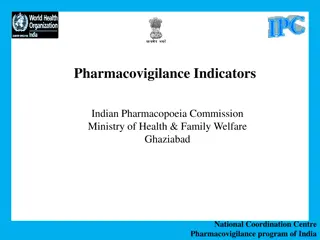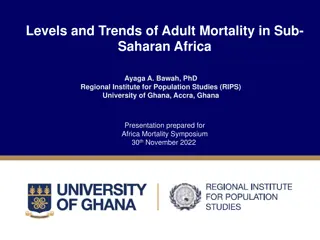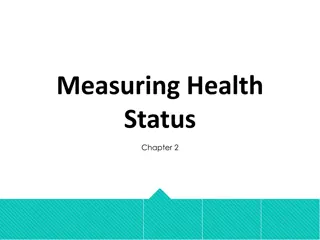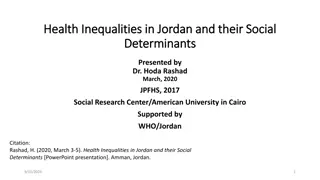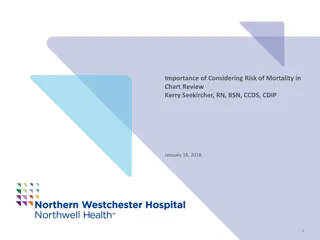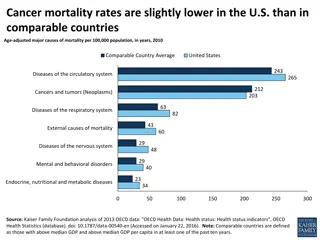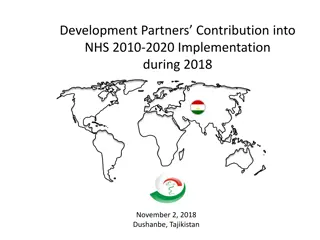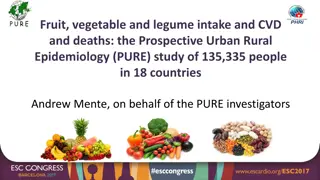Understanding Health Indicators: Calculating Mortality Rates in Communities
Learn how to calculate various mortality rates—such as crude mortality rate, proportionate mortality, case fatality rate, and cause-specific mortality rate—using real-life scenarios from communities like Adias and Wales. Understand the significance of these rates in assessing public health outcomes and prioritizing interventions effectively.
Download Presentation

Please find below an Image/Link to download the presentation.
The content on the website is provided AS IS for your information and personal use only. It may not be sold, licensed, or shared on other websites without obtaining consent from the author. Download presentation by click this link. If you encounter any issues during the download, it is possible that the publisher has removed the file from their server.
E N D
Presentation Transcript
Health Indicators Tutorial
Scenario 1: Adias is a community of 100,000 residents. During 2005, there were 1,000 deaths from all causes. 300 cases of tuberculosis were diagnosed in Adias in 2005. During 2005, there were 60 deaths from tuberculosis. Define: crude mortality rate, proportionate mortality, case fatality rate, cause specific mortality rate 1. Calculate the crude mortality rate in Adias. 2. Calculate the proportionate mortality in Adias due to tuberculosis. 3. Calculate the case fatality rate for tuberculosis in 2005 4. Calculate the cause-specific mortality rate for tuberculosis.
Adias is a community of 100,000 residents. During 2005, there were 1,000 deaths from all causes. 300 cases of tuberculosis were diagnosed in Adias in 2005. During 2005, there were 60 deaths from tuberculosis. 1- Calculate the crude mortality rate in Adias. Crude mortality rate= total no. of deaths / total population X 1000 = 1,000/ 100,000 X 1,000 = 10 per 1,000
Adias is a community of 100,000 residents. During 2005, there were 1,000 deaths from all causes. 300 cases of tuberculosis were diagnosed in Adias in 2005. During 2005, there were 60 deaths from tuberculosis. 2- Calculate the proportionate mortality in Adias due to tuberculosis. Proportionate mortality rate= deaths from particular cause (TB)/ total deaths X 100 = 60/ 1,000 X 100 = 6% * In 2005, 6% of all deaths in Adias were attributed to TB.
Adias is a community of 100,000 residents. During 2005, there were 1,000 deaths from all causes. 300 cases of tuberculosis were diagnosed in Adias in 2005. During 2005, there were 60 deaths from tuberculosis. 3- Calculate the case fatality rate for tuberculosis in 2005 Case fatality rate= Deaths dues to certain disease (TB)/ Total no. of cases of (TB) X 100 = 60/ 300 X 100 = 20% * In 2005, 20% of TB cases were fatal in Adias.
Adias is a community of 100,000 residents. During 2005, there were 1,000 deaths from all causes. 300 cases of tuberculosis were diagnosed in Adias in 2005. During 2005, there were 60 deaths from tuberculosis. 4- Calculate the cause-specific mortality rate for tuberculosis. Cause-specific mortality rate= deaths from particular cause (TB)/ total population X 100,000 = 60 / 100,000 X 100,000 = 60 per 100,000 * In 2005, deaths due to TB in Adias was 60 per 100,000
Scenario 2 In 2012, in Wales, the number of live births was 107,072. There were 477 fetal deaths (death at 28 or more weeks of gestation); 219 newborns dying under 7 days of age; 296 newborns dying under the age of 28 days; 439 infants dying under the age of 1 year. Define: Infant mortality rate, perinatal mortality rate, neonatal mortality rate and maternal mortality ratio Calculate infant mortality rate Calculate perinatal mortality rate Calculate neonatal mortality rate If there were 25 deaths due to maternal causes in Wales during 2012, calculate maternal mortality ratio
In 2012, in Wales, the number of live births was 107,072. There were 477 fetal deaths (death at 28 or more weeks of gestation); 219 newborns dying under 7 days of age; 296 newborns dying under the age of 28 days; 439 infants dying under the age of 1 year. 1- Calculate infant mortality rate Infant mortality rate= Total deaths from zero to less than one year of age / Total live births X 1,000 = 439 / 107,072 X 1,000 = 4.1 per 1,000
In 2012, in Wales, the number of live births was 107,072. There were 477 fetal deaths (death at 28 or more weeks of gestation); 219 newborns dying under 7 days of age; 296 newborns dying under the age of 28 days; 439 infants dying under the age of 1 year. 2- Calculate perinatal mortality rate Perinatal mortality rate= no. of stillbirths+no. of early neonatal death/total births(stillbirths+live births) X 1,000 = (477 + 219) / (477+ 107,072) X 1,000 = 6.47 per 1,000
In 2012, in Wales, the number of live births was 107,072. There were 477 fetal deaths (death at 28 or more weeks of gestation); 219 newborns dying under 7 days of age; 296 newborns dying under the age of 28 days; 439 infants dying under the age of 1 year. 3- Calculate neonatal mortality rate? Neonatal mortality rate= no. of death from zero up to less than 28 days of age / no. of live births X 1,000 = 296 / 107,072 X 1,000 = 2.76 per 1,000
In 2012, in Wales, the number of live births was 107,072. There were 477 fetal deaths (death at 28 or more weeks of gestation); 219 newborns dying under 7 days of age; 296 newborns dying under the age of 28 days; 439 infants dying under the age of 1 year. 4- If there were 25 deaths due to maternal causes in Wales during 2012, calculate maternal mortality ratio Maternal mortality rate= no. of maternal deaths / no. of live births X 100,000 = 25 / 107,072 X 100,000 = 23 per 100,000
Scenario 3 In the year 2000, City A had a population of 183,000. There were 264 existing cases of colon cancer, 40 of which were diagnosed in 2000. During the same year, 20 deaths were attributed to colon cancer. Define: prevalence, incidence, cause specific mortality rate, case fatality ratio Calculate the prevalence of colon cancer. Calculate the incidence of colon cancer in the year 2000. Calculate the cause-specific mortality rate for colon cancer. Calculate case fatality ratio for colon cancer
In the year 2000, City A had a population of 183,000. There were 264 existing cases of colon cancer, 40 of which were diagnosed in 2000. During the same year, 20 deaths were attributed to colon cancer. 1- Calculate the prevalence of colon cancer. Prevalence = no. of cases / population at risk X 1,000 = 264 / 183,000 X 1000 = 1.4 per 1,000
In the year 2000, City A had a population of 183,000. There were 264 existing cases of colon cancer, 40 of which were diagnosed in 2000. During the same year, 20 deaths were attributed to colon cancer. 2- Calculate the incidence of colon cancer in the year 2000. Incidence = No. of new cases / Population at risk X 1000 *Population at risk= 183,000 264 = 182,736 Incidence = 40 / 182,736 X 1,000 = 0.22 per 1,000
In the year 2000, City A had a population of 183,000. There were 264 existing cases of colon cancer, 40 of which were diagnosed in 2000. During the same year, 20 deaths were attributed to colon cancer. 3- Calculate the cause-specific mortality rate for colon cancer. Cause-specific mortality rate= deaths from particular cause (colon cancer)/ total population X 100,000 = 20 / 183,000 X 100,000 = 10 per 100,000
In the year 2000, City A had a population of 183,000. There were 264 existing cases of colon cancer, 40 of which were diagnosed in 2000. During the same year, 20 deaths were attributed to colon cancer. 4- Calculate case fatality ratio for colon cancer Case fatality rate= Deaths dues to certain disease (colon cancer) / Total no. of cases of (colon cancer) X 100 = 20/ 264 X 100 = 7,6%





